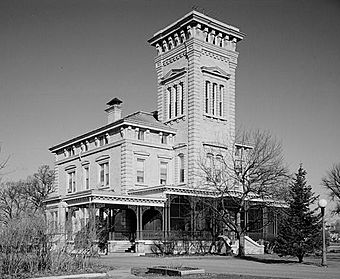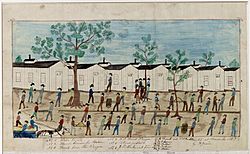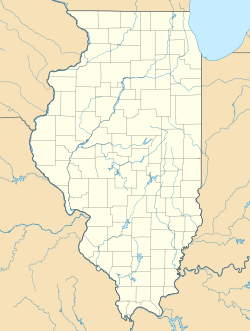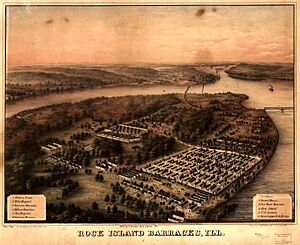Rock Island Arsenal facts for kids
Quick facts for kids Rock Island Arsenal |
|
|---|---|
| Rock Island Arsenal, Rock Island Township / Moline Township, Rock Island County, Illinois |
|
| Type | Army post |
| Site information | |
| Controlled by | U.S. Army |
| Site history | |
| Built | 1862 |
| In use | 1862–present |
| Garrison information | |
| Garrison | Joint Munitions Command Joint Manufacturing and Technology Center U.S. Army Corps of Engineers, Rock Island District United States Army Sustainment Command First United States Army |
|
Rock Island Arsenal
|
|

Rock Island Arsenal, Quarters 1 (Building 301)
|
|
| Location | Rock Island, Illinois |
|---|---|
| Built | 1832 |
| Architect | General Thomas J. Rodman et al. |
| Architectural style | Greek Revival, Italianate |
| NRHP reference No. | 69000057 |
| Significant dates | |
| Added to NRHP | September 30, 1969 |
| Designated NHLD | June 7, 1988 |
| Rock Island Military Prison | |
|---|---|
| Part of American Civil War prison camps | |

Union prison at Rock Island, during the American Civil War, circa 1863–1865
|
|
| Type | Union Prison Camp |
| Site information | |
| Owner | U.S. Government |
| Controlled by | Union Army |
| Open to the public |
No |
| Site history | |
| In use | December 1863-July 1865 |
| Battles/wars | American Civil War |
| Garrison information | |
| Occupants | Union soldiers, Confederate prisoners of war |
The Rock Island Arsenal is a large military base located on an island in the Mississippi River. This island, originally called Rock Island, sits between Davenport, Iowa, and Rock Island, Illinois. It covers about 946 acres. This important site is home to the U.S. Army First Army Headquarters. It is also a special center for making things with advanced manufacturing methods.
For thousands of years, the Sauk people, an indigenous group, used this island as their summer home. Later, European settlers arrived, leading to disagreements over land ownership. This conflict resulted in the Black Hawk War in 1832. In 1816, the U.S. Army built Fort Armstrong here. Its purpose was to protect river shipping after the War of 1812. Many years later, in the 1880s, the army started a factory and armory on the island. They made military equipment and weapons. Today, Rock Island Arsenal is the largest government-owned factory in the United States that makes weapons. In 1988, it was recognized as a National Historic Landmark.
At the start of the 1900s, the arsenal made weapons and leather gear for an army that still used horses. Now, it provides manufacturing, supplies, and support services for the U.S. Armed Forces. It is the only active U.S. Army factory that makes metal parts. It produces many items, including artillery, gun mounts, small arms, aircraft weapon parts, and grenade launchers. Some famous products include the M198 howitzer and M119 howitzer (large towed guns). It also makes parts for the M1 Abrams tank. About 250 military members and 6,000 civilians work at the arsenal. In 2020, 182 people lived on the island.
Contents
A Look Back: Rock Island Arsenal's History
From 1816 to 1862, this site was known as Fort Armstrong. Before that, Native American groups lived here for thousands of years. They chose the island because of its excellent location on the Mississippi River. The United States gained control of the island in 1804 through a peace treaty with the Fox and Sac Tribes. The U.S. Army did not occupy the island right away. It saw a small conflict at the start of the War of 1812. After that war, in 1814, the U.S. Army used the island as a guard post. This helped them control river traffic and watch over local Native American groups.
Black Hawk, a Sauk leader, wrote about the island. He said, "When we arrived we found that the troops had come to build a fort on Rock Island...We did not object, however, to their building their fort on the island, but were very sorry, as this was the best one on the Mississippi, and had long been the resort of our young people during the summer. It was our garden, like the white people have near their big villages, which supplied us with strawberries, blackberries, gooseberries, plums, apples and nuts of different kinds."
The Civil War Prison Camp
During the American Civil War, the army changed some buildings and built new ones in 1863. These new structures were not fully finished when the first Confederate prisoners arrived in December of that year. The buildings were quickly put together. The first prisoners were 468 Confederates captured in battles in Chattanooga, Tennessee. That month, more than 5,000 Confederates filled the Rock Island military prison. They lived in 84 barracks, with about 100 prisoners in each. A total of 41 Confederate prisoners managed to escape. Many more tried but failed, stopped by the powerful Mississippi River.
Sadly, many prisoners and guards died. A total of 1,964 Confederate prisoners and 125 Union guards are buried in the nearby military cemetery. The Union guards included 49 members of the 108th Regiment of United States Colored Troops. Most people died from diseases because sanitation was very basic, like in most army camps back then. They also faced very hot, humid summers and freezing winters. In 1864, dangerous smallpox outbreaks spread quickly through the prison. The prison camp operated from December 1863 until July 1865. After the war ended, the prison buildings were completely taken down. During its two years, the prison held over 12,400 Confederates.
Other historical places in the area include the Confederate Cemetery and the Rock Island National Cemetery. There are also old stone workshops, officers' homes along the river, and the site of the first railroad bridge built across the Mississippi. After the war, the government kept ownership of Arsenal Island. They developed it into an arsenal and weapon-making center, which led to the island's new name.
Women's Important Role in History
During World War I, the need for war supplies grew a lot. This meant more skilled workers were needed, but many men were sent to fight. So, women were hired to fill jobs at the arsenal. This was sometimes called the "women draft." They stepped in to keep factories running and meet the war's demands. Rock Island Arsenal went from having 175 female employees in 1914 to 300 in 1917. This was a big change, even before women had the right to vote. Women were extremely important to the success of the U.S. effort in World War I. They played a key part in production at Rock Island Arsenal.
Key Moments in Rock Island Arsenal's Past
- 1809: The island was officially made a federal military area by a law from Congress.
- 1816: Fort Armstrong was built on the island.
- 1818: George Davenport, an army supplier, set up a trading post.
- 1832: The island served as the U.S. Army's main base during the Black Hawk War.
- 1833: George Davenport's large house was built.
- 1836: The fort was left empty, but it remained a place to store weapons.
- 1845: George Davenport was killed by a group of outlaws.
- 1856: The first railroad bridge was built across the Mississippi River.
- 1862: Rock Island Arsenal, as we know it today, was officially created by Congress.
- 1862: Major Charles P. Kingsbury became the first commanding officer.
- 1863-1865: The Rock Island Prison Barracks were built for Confederate soldiers.
- 1865: Brevet Brigadier General Thomas J. Rodman became the second commanding officer. He is known as the "Father of Rock Island Arsenal" for his important work.
- 1867: The Clock Tower Building was built. It is still used today by the U.S. Army Corps of Engineers.
- 1871: The first military homes were built on Rock Island. One was a large Italian-style house called Quarters One. At 20,000 square feet, it is one of the biggest government homes for a single family in the U.S.
- 1872: The first Government bridge was built across the Mississippi River. It replaced the earlier railroad bridge that a steamboat had destroyed.
Rock Island Arsenal Museum
The Rock Island Arsenal Museum opened on July 4, 1905. It is the second-oldest U.S. Army Museum in the country, after the West Point Museum. The museum closed twice, during World War I and World War II. This was to make more room for manufacturing facilities during the wars.
The museum shows the history of Rock Island Arsenal. It also tells the story of the Union prison camp during the American Civil War. You can learn about the site's role as a military industrial facility. The museum has the second-largest collection of small weapons in the U.S. Army. There is also an outdoor display of military vehicles.
Museum Exhibits: Military Gear and Vehicles
| Weapon | Country of origin | Period |
|---|---|---|
| M1 75 mm Pack Howitzer | 1927–present | |
| M40A1 106 mm Recoilless Rifle | 1950s–present | |
| M45 Quadmount 50 caliber machine gun turret | World War II – 1980s | |
| M14 conversion display to M14 Enhanced Battle Rifle (RI) | 1959–present | |
| M65 Atomic Cannon | 1953–1963 | |
| M198 155 mm towed howitzer | 1979–present | |
| M119 105 mm towed howitzer | 1989–present | |
| M115 8-inch towed howitzer | 1931–1950s | |
| Type 59-1 130 mm Field Gun (Chinese version of Russian M46) | 1954–present | |
| M22 or T9E1 Locust Light Tank | World War II | |
| M4A3 Sherman Medium Tank with battle damage from the Battle of the Bulge in World War II with the 4th Armored Division | World War II | |
| M50 Ontos self-propelled anti-tank gun | 1956–1969 | |
| M51 Skysweeper towed anti-aircraft gun | 1953–1975 | |
| M1 Bofors 40 mm anti-aircraft gun | World War II | |
| D-44 85 mm Field Gun | 1945–1953 | |
| M2A1 105 mm howitzer | 1941–present | |
| XM123A1 Medium Auxiliary Propelled 155mm Howitzer (experimental model of M114 howitzer) | 1961 | |
| XM124E2 Light Auxiliary Propelled 105 mm howitzer (experimental model of M2 or M101 howitzer) | 1962–1965 | |
| M114 155 mm howitzer | 1942–present | |
| M2A2 Terra Star Auxiliary Propelled Howitzer with tri-star wheels | 1969–1977 | |
| 15 cm Nebelwerfer 41 Multiple Rocket Launcher | World War II | |
| XM70E2 Rocket Launcher | 1959–1963 | |
| M5 3 inch anti-tank gun | 1943–present | |
| M1 57 mm Anti-tank Gun | World War II | |
| M3 105 mm light howitzer (airborne) | 1943–present | |
| M55 self-propelled howitzer | 1970s | |
| MGR-1 Honest John surface-to-surface missile | 1954–1973 | |
| MGR-3 Little John surface-to-surface missile with XM80 launcher | 1961–1969 | |
| ZSU-23-4 "Shilka" self-propelled anti-aircraft gun | 1962–present |
Schooling for Families at Rock Island Arsenal
The area where people live on the arsenal is split between two school districts. These are the Rock Island–Milan School District 41 and the Moline-Coal Valley School District 40. The base provides a school bus service for children attending schools in the Moline district. The local school districts do not offer their own bus service. Most military families live in homes off the base in the wider area. This is because government housing on the arsenal is limited.
More to Explore





